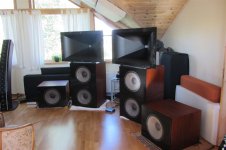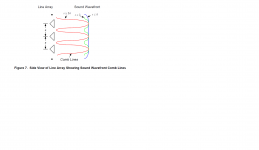http://www.diyaudio.com/forums/multi-way/100392-beyond-ariel-874.html#post3484671Tom Danley said:Fwiw, line sources are not dumb but like every “solution” it has tradeoffs and strengths. If loudspeakers were anything even remotely close to “perfect”, they would pass many generations in a generation loss recording, but they don’t, 3 or 4 passes is doing very very well.
The point is the are so many things wrong that there is no clear “best” solution. So many things wrong that when an early high resolution loudspeaker measurement was shown to a sharp electronic circuitry engineer, he said, huh, well whatever it is, it’s broken.
What can we hear? That is a valid question. We put wool or absorbent stuff around dome tweeters and mids, we try to avoid refractions in drivers surroundings and one can hear Higher order modes within a horn when you can hear with and without. All of these things considered to be adverse to sound quality are occurring in very short periods in time, <<3ms. People fret about response too 20KHz too but how large is that wavelength or quarter wavelength?
Intelligibility, the ability to understand random words (not sentences), this can only be measured by using a big list of words and large number of individual listeners. A legal indicator of intelligibility is the STIpa measurement which has proven to correlate to the measured data and is essentially language independent.
It works by using the Modulation Transfer Function measurement (google), the most familiar of these is the one used for optics. In the image below, line A is perfect on off modulation, line B is what limiting the MTF does and the black / while transitions show the loss of resolution that results.
http://photo.net/learn/optics/mtf/blur2.gif
The STIpa measurement uses 7 frequency bands (weighted to a speech spectrum) and performs a MTF measurement in each band.
Anything that “fills in” the off periods or inhibits the source form being on/off at that rate degrades the MTF.
Now, one might wonder is an optical style measurement of resolution applicable to musical audio?
I really think so but that answer to that like anything like single ended evaluation of a recording and musical, that is subjective.
So to me yes I think so but as far as an indicator / predictor of being able to hear/ understand random words, no doubt yes, that is proven.
Here is where reflected sound, reverberant sound and multiple arrivals, distortion and a myriad of other things all degrade the MTFs (and resolution I think).
For those with ARTA, it has an MTF measurement although little or no explanation how to read it. Each one is an a frequency band and shows an increasing rate of modulation and normally decreasing mtf reading.
AS one moves a mic away from the loudspeaker to the lp, one can see even then the MTF at the highest rates is degraded. Fwiw, I had attended an intelligibility seminar this spring and I asked the fellow who did research how high our hearing mtfs extended and he said they stopped around 30hz but only needed much lower rates for speech intelligibility.
The reason line arrays are normally curved or J shape is that a finite line array has very strong frequency dependent and position dependent behavior. That makes them an astigmatic point source instead of a cylindrical source. Don Keeles CBT sonar arrays take that farther and shade the amplitude away from center making them much more “constant” over a bandwidth.
In your case, you do have an opportunity to bypass most all the problems the commercial line arrays in live sound all face, you can extend yours floor to ceiling AND then you have thrown out ALL of those finite source length issues with a real (in the acoustic sense) line source, at least up to where your sources are ¼ wl apart.
Using your floor and ceiling as an acoustic mirror are the only ways possible to do that in the real world and yours already starts at the floor (making it acoustically twice as long already).
If you haven’t built yet, consider it, I have heard a couple true line sources made like this and they can be impressive and perform very well.
Best,
Tom
I have mor or less settled on the quasi infinite array, and this comment from Monte Kay on his home page mfk-projects theater main speakers pretty much nails it:
The main left/right speakers are "near" infinite line. The array is 8' tall mounted 1' off the floor thus leaving a 1' gap between array and boundary at each end. There are eighteen Dayton Reference 6” truncated frame mid-bass drivers and forty two 2” Aura mid-tweeters in the array. Originally no shading was used but with encouragement from Don Keele I later added Hann shading to the array. I no longer believe that shading is the best approach nor is CBT. (Sorry Don) I believe instead that in a situation where a true infinite line is possible, it is the better approach. Problem with any line array other than CBT is that they only work well if the listening position is in the center. With an infinite line, no matter where you are, you are in the center so problem solved. Where infinite line is not possible however, CBT is definitely the best approach. I view the CBT as the perfect solution for finite line arrays, in fact CBT is really the only mathematically correct way to build a finite line array.
The main left/right speakers are "near" infinite line. The array is 8' tall mounted 1' off the floor thus leaving a 1' gap between array and boundary at each end. There are eighteen Dayton Reference 6” truncated frame mid-bass drivers and forty two 2” Aura mid-tweeters in the array. Originally no shading was used but with encouragement from Don Keele I later added Hann shading to the array. I no longer believe that shading is the best approach nor is CBT. (Sorry Don) I believe instead that in a situation where a true infinite line is possible, it is the better approach. Problem with any line array other than CBT is that they only work well if the listening position is in the center. With an infinite line, no matter where you are, you are in the center so problem solved. Where infinite line is not possible however, CBT is definitely the best approach. I view the CBT as the perfect solution for finite line arrays, in fact CBT is really the only mathematically correct way to build a finite line array.
I've currently got a pair of floor-to-ceiling arrays in my living room. They use thirty 3" full-range drivers a side. Below 80 hz my subs take over. The speakers sound very nice: they sound very big in a natural way, cause little listening fatigue and I like that they don't get much louder as you approach them. However, I do miss some precision and detail. They don't have that see-through quality my unidirectional (cardioid + waveguide) speakers have. Perhaps that would be better if the speaker had tweeters as well.
Interesting, could that be because of high frequency lobing due to the full range drivers? I also think of starting out with fullrangers and maybe add tweeters later.
Omholt:
Nice horns! Are those Klipsch K-402? What drivers are you using? Unfortunately I don't have room for horns in my living room for the time being. I'll try line arrays to have horn like sensitivety and headroom in a small foot print.
Omholt:
Nice horns! Are those Klipsch K-402? What drivers are you using? Unfortunately I don't have room for horns in my living room for the time being. I'll try line arrays to have horn like sensitivety and headroom in a small foot print.
jeno:
That's correct. Klipsch K-402. I'm temporarily using the K69 original driver while I'm waiting for JBL 2446 with Truextent Be to arrive.
I'm sure you will pleased with a CBT or an infinite array (if latter measures as well or better). So far and without the best EQ settings for K-402, I would say CBT36 and the K-402 sound more similar then different. In this room and with this spesific placement, the early reflections are taking care of without any treatment with both of them.
That's correct. Klipsch K-402. I'm temporarily using the K69 original driver while I'm waiting for JBL 2446 with Truextent Be to arrive.
I'm sure you will pleased with a CBT or an infinite array (if latter measures as well or better). So far and without the best EQ settings for K-402, I would say CBT36 and the K-402 sound more similar then different. In this room and with this spesific placement, the early reflections are taking care of without any treatment with both of them.
Interesting, could that be because of high frequency lobing due to the full range drivers? I also think of starting out with fullrangers and maybe add tweeters later.
Omholt:
Nice horns! Are those Klipsch K-402? What drivers are you using? Unfortunately I don't have room for horns in my living room for the time being. I'll try line arrays to have horn like sensitivety and headroom in a small foot print.
Yes.
It's basic geometry:
If you have two sources playing 17,000hz, as soon as the pathlength difference between those two sources is more than half a centimeter they're going to interfere destructively.
With a line array, that's basically every position in the room.
This is why we have curved arrays and why we have shaded arrays. You can't change the fact that the two sources will interfere, but you can reduce the effect of that interference by moving and/or reducing the level of the other source. Amplitude shading and curvature does that.
I have mor or less settled on the quasi infinite array, and this comment from Monte Kay on his home page mfk-projects theater main speakers pretty much nails it:
The main left/right speakers are "near" infinite line. The array is 8' tall mounted 1' off the floor thus leaving a 1' gap between array and boundary at each end. There are eighteen Dayton Reference 6” truncated frame mid-bass drivers and forty two 2” Aura mid-tweeters in the array. Originally no shading was used but with encouragement from Don Keele I later added Hann shading to the array. I no longer believe that shading is the best approach nor is CBT. (Sorry Don) I believe instead that in a situation where a true infinite line is possible, it is the better approach. Problem with any line array other than CBT is that they only work well if the listening position is in the center. With an infinite line, no matter where you are, you are in the center so problem solved. Where infinite line is not possible however, CBT is definitely the best approach. I view the CBT as the perfect solution for finite line arrays, in fact CBT is really the only mathematically correct way to build a finite line array.
What Monte Kay says is only true if you ignore the Y and the Z axis.
We live in a three dimensional world, and due to that, an infinite array is going to suffer from tons and tons of comb filtering.
Keele's solution will work better.
Only above 1 wavelength CTC frequency. The line in question need only operate to that frequency before handing off to another higher freq driver. Preferably of similar horizontal dispersion
No.
This is basic pythagorean theorem:
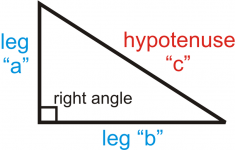
The distance to the top of the array will be longer than the distance to the center of the array. The center to center spacing doesn't change that.
You could have a center-to-center spacing of 1/4", and that would still be true.
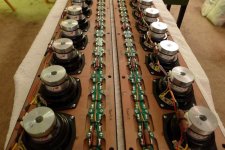
Keele doesn't use huge banks of resistors For The Lulz, it's to reduce the output so that the radiation from one edge of the array doesn't screw up the radiation from the other. Again, geometry.
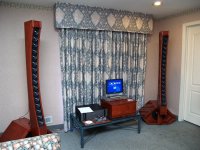
A focused array is another solution. But the curvature is dependent on the listening distance, so it's not a good solution for a concert. Which is what Keele designed the CBT for.
Keele's CBT would not work well from floor to ceiling in a room. Imagine using the shading and now add the mirror of that line from the ceiling. There is a reason the bottom speaker has full output in Keele's curved array.
While you are right about the distance from a floor to ceiling array being different from the top to the listening position and the on axis center position to the listening position but you should also keep in mind the off axis angle to that top speaker. In most situations the output will be reduced due to off axis listening to that top speaker (not to mention it is further away). Now add the virtual mirror sources from floor and ceiling and from the listening position it mimics a giant curve.
In other words, it doesn't seem right to add shading for a straight floor to ceiling array.
For example: Keele talks about the floor reflection a lot in his papers. (Somehow he doesn't mention it for the straight arrays)
Now look at the non Keele curved array in the picture above. Imagine the floor and ceiling reflection from that array... would it add up right?
I'd say it is not helping that particular curved array at all.
While you are right about the distance from a floor to ceiling array being different from the top to the listening position and the on axis center position to the listening position but you should also keep in mind the off axis angle to that top speaker. In most situations the output will be reduced due to off axis listening to that top speaker (not to mention it is further away). Now add the virtual mirror sources from floor and ceiling and from the listening position it mimics a giant curve.
In other words, it doesn't seem right to add shading for a straight floor to ceiling array.
For example: Keele talks about the floor reflection a lot in his papers. (Somehow he doesn't mention it for the straight arrays)
Now look at the non Keele curved array in the picture above. Imagine the floor and ceiling reflection from that array... would it add up right?
I'd say it is not helping that particular curved array at all.
Last edited:
No. These are line arraysNo.
This is basic pythagorean theorem:...
You need to tell the owners of arrays that are enjoying them. And the researchers writing papers.
There is a time difference across your 15" woofer? There is time difference end to end of a continuous array like a BG?
DB Keele's arrays have time difference as part of their design?
But, your saying this can't work with high sound quality?
...We live in a three dimensional world, and due to that, an infinite array is going to suffer from tons and tons of comb filtering...
Is it the word "Infinite" making you use the phrase "tons and tons". If the lobes you are referring to did have weight, it would not be many multiples of 2000lbs
My response implied that is only true for frequencies close to and above a wavelength of the CTC spacing. Below I show an image borrowed from Jim Griffin's line array paper. I believe it is self explanatory, or at least I already did...
Do you disagree with Dr. Griffin?
Attachments
Absolutely. Griffin's arrays make everything sound HUUUUUUGE. I haver personally built a Griffin array, and I have personally listened to half a dozen of his. It's a fun effect if you don't care about fidelity. (And I'm not being sarcastic here; there are definitely speakers which are not hi-fidelity but are FUN.)
But if you want something realistic, the approach of Quad, Danley, Keele, etc works better. Their solutions can go big AND small. IE, when you're listening to a solo male vocal on a Quad or a Danley, the sound of the vocalist is appropriately sized. On a Griffin array the sound of a vocalist is ten feet tall.
Also, as far as Griffin's illustration goes, that's consistent with what I said in post 51 (http://www.diyaudio.com/forums/multi-way/243861-floor-ceiling-array-vs-cbt-6.html#post4039885). Griffin's diagram is one dimensional; and we live in a three dimensional world. Griffin's arrays work fine in a one dimensional world.
But if you want something realistic, the approach of Quad, Danley, Keele, etc works better. Their solutions can go big AND small. IE, when you're listening to a solo male vocal on a Quad or a Danley, the sound of the vocalist is appropriately sized. On a Griffin array the sound of a vocalist is ten feet tall.
Also, as far as Griffin's illustration goes, that's consistent with what I said in post 51 (http://www.diyaudio.com/forums/multi-way/243861-floor-ceiling-array-vs-cbt-6.html#post4039885). Griffin's diagram is one dimensional; and we live in a three dimensional world. Griffin's arrays work fine in a one dimensional world.
Last edited:
What is a "Griffin Array"? His paper is full of research and guidelines. There have been a couple like Needles and Linus I guess, most of which were modified by the builder that I saw. Or built/sold by someone else.Absolutely. Griffin's arrays make everything sound HUUUUUUGE. I haver personally built a Griffin array, and I have personally listened to half a dozen of his....
Well, I can agree to some of that. Not at all my point I wanted to get across to you or the others interested.But if you want something realistic, the approach of Quad, Danley, Keele, etc works better. Their solutions can go big AND small. IE, when you're listening to a solo male vocal on a Quad or a Danley, the sound of the vocalist is appropriately sized...
Well, as I said, only above CTC=1 wavelength. And, within reason, not at all what you said below that frequency. ..."an infinite array is going to suffer from tons and tons of comb filtering"...Really, no mention of freq or Y and Z? I would think the actual axis your focused on would be the Y and not the X? As far as 3D world, if you hadn't wanted to exaggerate and interject your opinion, you would not be stuck in one dimension. The Griffin image is 2 dementions, intentionally, to foster understanding.Also, as far as Griffin's illustration goes, that's consistent with what I said in post 51 (http://www.diyaudio.com/forums/multi-way/243861-floor-ceiling-array-vs-cbt-6.html#post4039885). Griffin's diagram is one dimensional; and we live in a three dimensional world. Griffin's arrays work fine in a one dimensional world.
This is going no-where...
Last edited:
In my world, apparent soundstage "size" is more or less unrelated to the type of speaker, and is related to the way the speakers are set up, and where you are sitting.
The soundstage ought to be in front of you with a tall un-tapered line array, no matter where you are in the vertical plane (so long as you are not in the farther field where a non-floor-to-ceiling-array has certain issues). The size of the apparent sound field ought to be no different than any other "small" speaker assuming you are on axis in height to said smaller speaker.
Having said that, take a recording that is made two mic and at "normal distances" (similar to the listening position to speaker vs. mic to performer ratio) and listen on the "big" line array. I think you might find it sounds very natural. It's the pan-potted recording that is un-naturally large in soundstage, and on typical 2-3way speakers is made artificially "small" in many cases.
Otoh, properly done speakers (without distortions, artifacts and overly bright tweeters) of the usual sort are perfectly capable of a large soundfield when listened to in the proper placement. Imo, of course.
It's most sound level and the distance to your ears from the speakers that governs the apparent size of the soundfield... try sitting far too close, inside the 45 degree triangle by a lot - what do you get? BIG BIG soundstage.
Just my perceptions. But I have three ears, so it may be different for me than you!
The soundstage ought to be in front of you with a tall un-tapered line array, no matter where you are in the vertical plane (so long as you are not in the farther field where a non-floor-to-ceiling-array has certain issues). The size of the apparent sound field ought to be no different than any other "small" speaker assuming you are on axis in height to said smaller speaker.
Having said that, take a recording that is made two mic and at "normal distances" (similar to the listening position to speaker vs. mic to performer ratio) and listen on the "big" line array. I think you might find it sounds very natural. It's the pan-potted recording that is un-naturally large in soundstage, and on typical 2-3way speakers is made artificially "small" in many cases.
Otoh, properly done speakers (without distortions, artifacts and overly bright tweeters) of the usual sort are perfectly capable of a large soundfield when listened to in the proper placement. Imo, of course.
It's most sound level and the distance to your ears from the speakers that governs the apparent size of the soundfield... try sitting far too close, inside the 45 degree triangle by a lot - what do you get? BIG BIG soundstage.
Just my perceptions. But I have three ears, so it may be different for me than you!
But I have three ears, so it may be different for me than you!  [/QUOTE]
[/QUOTE]
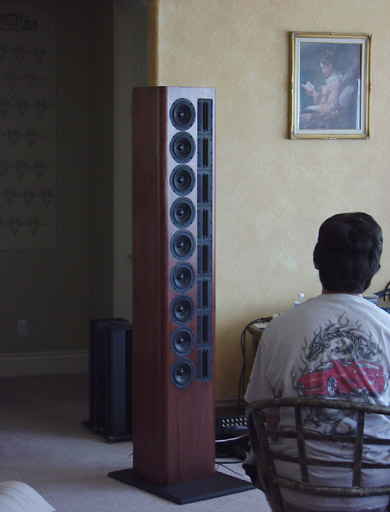
I find that arrays built as described in the Griffin paper make everything sound ten feet tall.
The reason for this is simple; there are sound sources from floor to ceiling. So our ears perceive a source that's ten feet tall.
Though Quads are nearly as large, I find that they don't sound "big". I believe this is because they basically emulate a coaxial. IE, the frequencies which are most susceptible to comb filtering - the high frequencies - only radiate from a small fraction of the speaker, in the center.

I find that arrays built as described in the Griffin paper make everything sound ten feet tall.
The reason for this is simple; there are sound sources from floor to ceiling. So our ears perceive a source that's ten feet tall.
An externally hosted image should be here but it was not working when we last tested it.
Though Quads are nearly as large, I find that they don't sound "big". I believe this is because they basically emulate a coaxial. IE, the frequencies which are most susceptible to comb filtering - the high frequencies - only radiate from a small fraction of the speaker, in the center.
- Status
- This old topic is closed. If you want to reopen this topic, contact a moderator using the "Report Post" button.
- Home
- Loudspeakers
- Multi-Way
- Floor-to-ceiling array vs CBT
